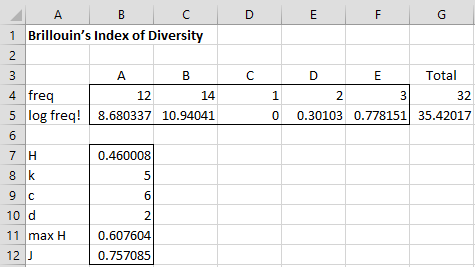Basic Concepts
For a population (or a non-random sample), we can use Brillouin’s index of diversity, instead of Shannon’s index. Brillouin’s index is defined as
where ni is the number of observations from the sample in the ith of k (non-empty) categories and n is the sample size
The maximum value of H is
where c = INT(n/k) and d = MOD(n, k).
Finally, Brillouin’s index of relative diversity is J = H/Hmax.
Example
Example 1: Find Brillouin’s index of diversity and index of relative diversity for a population distributed among five categories as shown in range B4:F4 of Figure 1.
Figure 1 – Population Index of Diversity
Figure 1 shows these two indices. Here, cell G4 contains the formula =SUM(B4:F4), cell B5 contains the formula =LOG10(FACT(B4)), cell G5 contains =LOG10(FACT(G4)), cell B7 contains the formula =(G5–SUM(B5:F5))/G4, cell B8 contains =COUNTA(B3:F3), cell B9 contains =INT(G4/B8), cell B10 contains =MOD(G4,B8) and cell B11 contains the formula
=(LOG10(FACT(G4))–(B8-B10)*LOG10(FACT(B9))–B10*LOG10(FACT(B9+1)))/G4
and cell B12 contains the formula B7/B11.
Calculation refinements
Note that the Excel function =FACT(n) only works for non-negative integer values for n ≤ 170. For larger values, we need to take advantage of the fact that n! = Γ(n+1) where Γ(x) is the gamma function, as described in Gamma Function. In particular, we can calculate ln(n!), the natural log of n!, in Excel by the formula =GAMMALN(n+1). The log base 10 of n! can be calculated by =GAMMALN(n+1)/LN(n+1).
Examples Workbook
Click here to download the Excel workbook with the examples described on this webpage.
Reference
Krebs, C. J. (2014) Species diversity measures
https://www.zoology.ubc.ca/~krebs/downloads/krebs_chapter_13_2017.pdf

Hi Professor Charles,
My doubt is with the cell B10 and its calculation. My excel version do not have the funcion MOD. Can you explain where the number 2 (“d”) is comming from the exercise numbers?
Att.
Diego
Hello Diogo,
I believe that MOD is called RESTO in Portuguese. In any case,
MOD(n, d) = n – d*INT(n/d)
Charles
Hi Charles
Thank you so much for this stats package, the examples are so easy to follow. My problem is that Excel, as far as I can tell, cannot factorise numbers larger than 170. Is there any way around this
Matthew,
While you can’t calculate n!, you can calculate log(n!). If the log is base e (i.e. the natural log), then you can use the Excel formula =GAMMALN(n+1). If you need log(n!) with base 10, then you can use the formula =GAMMALN(n+1)/LN(10).
Charles
where can i find more example to practice ?
Hi Karen,
I believe that the information for this part of the website is derived from the following textbook:
Zar. J. H. (2010) Biostatistical analysis 5th Ed. Pearson
Charles